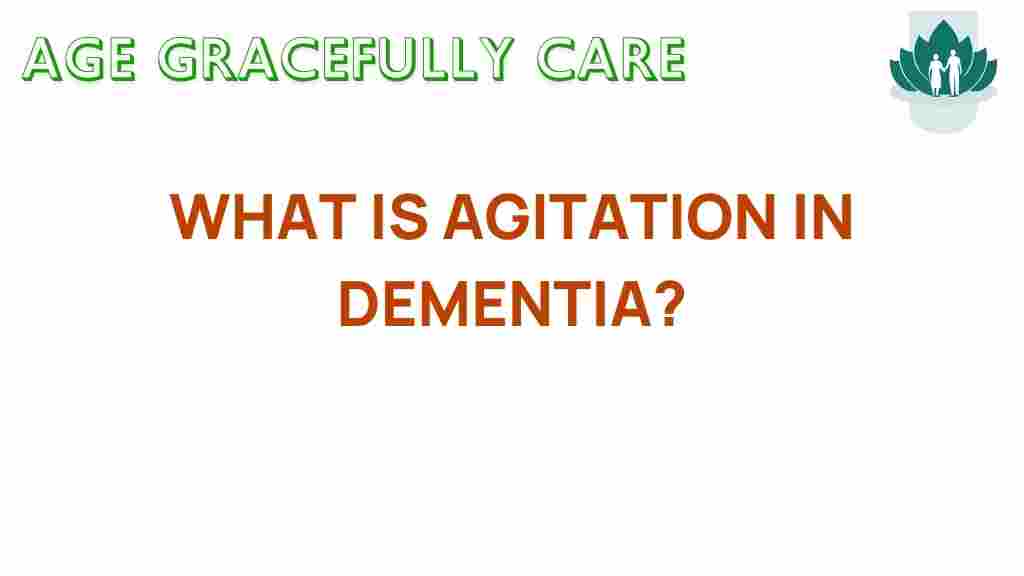Understanding Agitation in Dementia: Unraveling the Causes and Solutions
Dementia is a complex condition that affects millions of individuals worldwide, leading to various cognitive impairments and behavioral changes. Among these changes, agitation is one of the most challenging symptoms for both patients and caregivers. Understanding agitation in dementia is crucial for effective caregiving and improving the mental health of those affected.
This article aims to delve deep into the causes of agitation, its symptoms, and the effective strategies for treatment and support. By gaining a comprehensive understanding of agitation in dementia, caregivers can provide better support and improve the quality of life for those with dementia.
What is Agitation in Dementia?
Agitation in dementia is characterized by a range of behaviors that may include restlessness, pacing, yelling, or physical aggression. These behaviors can be distressing for both the individual and their caregivers. Agitation can occur in any stage of dementia but is more prevalent in the later stages.
Common Symptoms of Agitation
Recognizing the symptoms of agitation is the first step in understanding how to manage it effectively. Common symptoms include:
- Restlessness or fidgeting
- Pacing or wandering
- Increased verbal or physical aggression
- Changes in mood, such as sudden anger or sadness
- Difficulty following directions or tasks
- Withdrawal from social interactions
Causes of Agitation in Dementia
Understanding the underlying causes of agitation can help caregivers respond more effectively. The causes can be grouped into several categories:
1. Physical Causes
Physical discomfort is often a significant trigger for agitation. This can include:
- Pain or discomfort from medical conditions
- Hunger or thirst
- Fatigue or lack of sleep
- Medication side effects
2. Environmental Triggers
The environment plays a critical role in the behavior of individuals with dementia. Common environmental triggers include:
- Loud noises or chaotic surroundings
- Changes in routine or unfamiliar settings
- Overstimulation from visual or auditory stimuli
3. Psychological Factors
Agitation can also stem from psychological distress. Factors to consider include:
- Feelings of confusion or fear
- Depression or anxiety
- Loss of control over one’s life
4. Communication Difficulties
As dementia progresses, communication becomes more challenging. Misunderstandings can lead to frustration and agitation.
Step-by-Step Process for Managing Agitation
Managing agitation in dementia involves a comprehensive approach that includes understanding triggers, providing appropriate support, and implementing effective strategies.
Step 1: Identify Triggers
The first step in managing agitation is identifying potential triggers. Caregivers should observe the individual closely to recognize patterns in behavior. Ask the following questions:
- What activities precede the agitation?
- Are there specific times of day when agitation occurs?
- What environmental factors seem to contribute to agitation?
Step 2: Create a Calm Environment
A calm and structured environment can significantly reduce agitation. Consider the following tips:
- Minimize noise and distractions.
- Maintain a consistent daily routine.
- Provide a comfortable, familiar space.
Step 3: Use Nonverbal Communication
Since verbal communication can be challenging, caregivers should utilize nonverbal cues. Here are some effective strategies:
- Use gentle touch to reassure and connect.
- Maintain eye contact to show attentiveness.
- Employ calming facial expressions and gestures.
Step 4: Engage in Activities
Engaging the individual in enjoyable activities can redirect their focus and reduce agitation. Consider activities such as:
- Listening to music
- Looking through photo albums
- Gardening or simple crafts
Step 5: Provide Reassurance and Comfort
During moments of agitation, it’s essential to provide reassurance. Use calming phrases and acknowledge their feelings. Validate their emotions, saying things like, “I understand that you are upset, and I’m here to help.”
Step 6: Consult Healthcare Professionals
If agitation persists despite implementing strategies, it may be necessary to consult healthcare professionals. They can evaluate for potential medical causes and recommend appropriate treatments, including:
- Medication adjustments
- Therapeutic interventions
- Behavioral therapy
Troubleshooting Tips for Caregivers
While managing agitation can be challenging, caregivers can implement several troubleshooting tips to help mitigate symptoms:
- Stay Calm: Your demeanor can influence the individual’s feelings. Maintain a calm and composed presence.
- Use Distraction Techniques: Redirect their attention to a different subject or activity.
- Practice Patience: Understand that agitation may not resolve immediately, and give the individual time to settle down.
- Educate Yourself: Understanding dementia and its complexities can better prepare caregivers for challenges.
- Seek Support: Join support groups for caregivers to share experiences and coping strategies. Find more resources here.
Conclusion
Understanding agitation in dementia is essential for effective caregiving. By recognizing the symptoms, identifying triggers, and implementing supportive strategies, caregivers can significantly improve the quality of life for individuals with dementia. Remember that agitation is often a manifestation of underlying issues, and addressing these can lead to better outcomes.
Every individual with dementia is unique, and what works for one person may not work for another. Continuous learning and adapting strategies are key components of successful caregiving. With the right tools and support, caregivers can help navigate the complexities of dementia and promote mental health and well-being for both themselves and those they care for.
For more insights into dementia care, refer to our comprehensive caregiving resources here.
This article is in the category Care and created by AgeGracefullyCare Team
